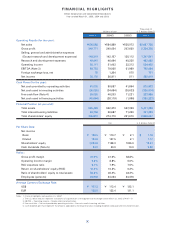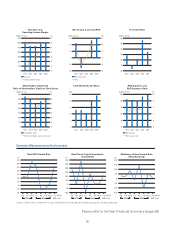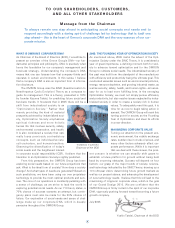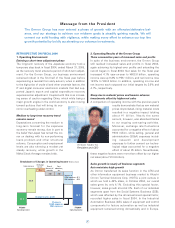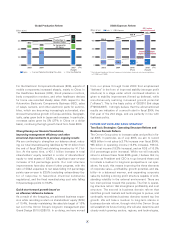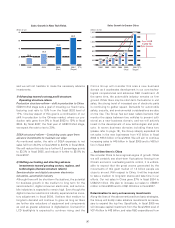Omron 2005 Annual Report Download - page 16
Download and view the complete annual report
Please find page 16 of the 2005 Omron annual report below. You can navigate through the pages in the report by either clicking on the pages listed below, or by using the keyword search tool below to find specific information within the annual report.
(3) Laser radar and Tire Pressure Monitoring Systems—securing vehicle safety
The Advanced Safety Vehicle
(ASV), a vehicle that can ensure
safety by assessing situations on
its own by way of features such as
lane keep systems and collision-
damage mitigating braking, is
coming into practical use. Against
this backdrop, the Omron Group is
marketing a laser radar based on
optical sensing technology that maintains a fixed distance between a vehi-
cle and the vehicle in front of it, and supports safe driving. As this product
can be offered at lower prices than expensive milliwave radars, we aim to
market it not only for luxury cars, but also for economy cars. The product
realizes high performance by carrying out efficient and high-precision sens-
ing that concentrates laser light only in the range where vehicles in front
may exist, and by enabling the detection of pedestrians several tens of
meters ahead (which was difficult to achieve with milliwaves). The laser
radar is already available with the new models of major domestic automo-
bile manufacturers.
At the same time, from fiscal 2005 we will introduce to the North
American market the Tire Pressure Monitoring System (TPMS), an applica-
tion of our radio wave sensing technology. The TPMS receives information from sensors located in each of the four tires via
the high-frequency receiver of a wireless central processing unit. It performs concentrated management of the information,
conveys information regarding tire pressure and internal temperature to the driver, and sounds an alarm in cases of abnor-
mality. In North America, where long-distance travel is common, the need for this system is rising rapidly, and installation of
TPMS devices on all vehicles is scheduled to be compulsory in the future.
(4) A solution to improve product quality—machines accumulate expertise comparable to skilled inspectors
Even at automobile production sites on the cutting edge of
automation, in the engine inspection process, skilled inspec-
tors are the ones who detect defective items by checking
sounds and vibrations. Therefore, the Omron Group has col-
lected data on the waveforms of sounds and vibrations through
its original analytical technology, and developed an Auto Sen-
sory Inspection System that can judge sounds and vibrations
as well as skilled inspectors. Over long years of working to
improve manufacturing processes, the Omron Group has trans-
lated into algorithms the know-how of skilled inspectors and
their insights into the genesis of defective products. We are
combining sensing technology and fuzzy logic methods with
this accumulated digital expertise, and evolving our quality
guarantee approach from “eliminating outflow of defective
items to the market” to “establishing high-quality processes”
(i.e., processes that do not generate defective items). More-
over, we are researching “growing production equipment” that
generates greater quality and productivity with each use. This
equipment accumulates production and inspection data for
each manufacturing process, which can be used at all times to
discover causes of defects and for the analysis of line improve-
ments. The data can assist in setting optimal manufacturing
conditions, and predicting the occurrence of defective items.
Post-printing
inspection machine
(P inspection machine)
Post-mounting
inspection machine
(Z inspection machine)
Post-reflow
inspection machine
(S inspection machine)
P/Z/S 3-process
verification
(using images
and data)
Defect cause
inference
variation control
Reduction of
over-inspection
DB
Q-upNavi System
Signarc System
Manufacturing processes are improved in the PCB line through a 3-process verification that
integrates the results obtained during each of the processes of printing (P), mounting (Z), and
reflow (S).
Quality
guarantee division
Development
and design division
Auto Sensory Inspection System
Vibration sensorMIC
Control panel
(customer)
Production line
Office
Quality control and
analysis server
Knowledge from the
manufacturing floor
condensed into algorithms
Controller
Display device
Buzzer
Brake actuator
Automatic following distance
control system
Laser radar sensor
Brake fluid pressure
Brake fluid pressure
Alarm Elapsed time
Elapsed time
Braking
14


